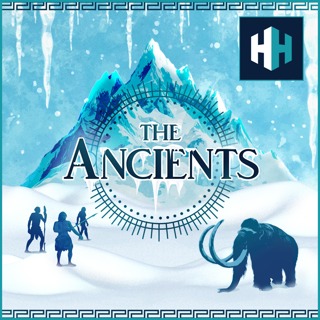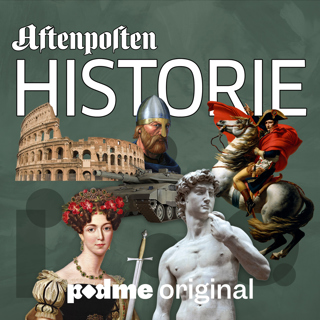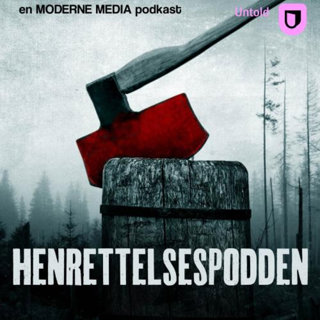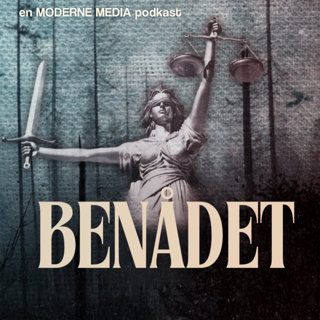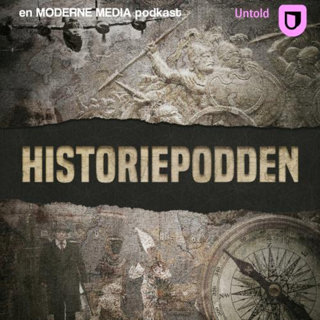
End of Stone Age Orkney
Around 5200 years ago, during the Neolithic period, when farming first took hold, Orkney was a hugely influential cultural centre. Yet, as Europe moved into the Bronze Age, the islands’ influence dwindled and Orkney became more insular. But what do we know about the arrival of the Bronze Age in Orkney and Scotland?In today’s episode of The Ancients, Tristan is joined by Professor Martin Richards from University of Huddersfield, one of the leaders of an exciting new research project. Working along side researchers who uncovered DNA evidence that brings to light new information for this moment of Britain’s prehistory, Martin and the team's work is helping change the way Stone Age Orkney is viewed.By combining archaeology with the study of ancient DNA from Bronze Age human remains, researchers now know much more about this time than ever before, and the results have come as a great surprise to geneticists and archaeologists alike.To watch our brand new documentary series on Prehistoric Scotland click here:https://access.historyhit.com/ancient-and-classical/videos/mysteries-of-prehistoric-scotland-episode-oneFor more Ancients content, subscribe to our Ancients newsletter here. For your chance to win five non-fiction history books - including a signed copy of Dan Snow's On This Day in History - please fill out this short survey: https://www.surveymonkey.co.uk/survey-taken/?sm=IthGeoCcJUiKNx0R8Pv7Ogn50xYWgriQdyDMjMZwy8jmNE1jQh63NtWjK1DQdAssMjnsuFzX5eJOGw0w3NS4sgHthi59y72wWjesdfmNxyU_3DIf you'd like to learn even more, we have hundreds of history documentaries, ad free podcasts and audiobooks at History Hit - enter promo code ANCIENTS for a free trial, plus 50% off your first three months' subscription.To download, go to Android > or Apple store > Hosted on Acast. See acast.com/privacy for more information.
16 Okt 202228min

Rosetta Stone
In July 1799 a group of French soldiers stumbled upon a stone that was set to change our understanding of the ancient world.The iconic Rosetta Stone, a stela or inscribed slab, was dug up in the foundations of a fort in the town of Rasheed - a port city east of Alexandria. The Stone was central in kickstarting antiquarians such as Jean-Francois Champollion and Thomas Young down the path of unlocking ancient Egypt’s enigmatic language within just c.20 years of the Stone's rediscovery. Today, it ranks amongst the most famous artefacts in the world. So what exactly is it? And what does it say?To explain the Rosetta Stone and so much more, Tristan interviews Dr Ilona Regulski, curator of the British Museum’s new exhibition 'Hieroglyphs Unlocking Ancient Egypt'. Looking at the hieroglyph script and how it was deciphered, alongside key figures in the race to decipherment, such as Jean-Francois Champollion, Thomas Young, William Bankes, it's an event not to be missed.If you want to find out more about the exhibition click here: https://www.britishmuseum.org/exhibitions/hieroglyphs-unlocking-ancient-egypt?gclid=Cj0[…]L_5Yn8vOaYEdKDmCGW6_SQo9UMZqsHuriJctr1WMm5z8kaAl-dEALw_wcBFor more Ancients content, subscribe to our Ancients newsletter here. For your chance to win five non-fiction history books - including a signed copy of Dan Snow's On This Day in History - please fill out this short survey: https://www.surveymonkey.co.uk/survey-taken/?sm=IthGeoCcJUiKNx0R8Pv7Ogn50xYWgriQdyDMjMZwy8jmNE1jQh63NtWjK1DQdAssMjnsuFzX5eJOGw0w3NS4sgHthi59y72wWjesdfmNxyU_3DIf you'd like to learn even more, we have hundreds of history documentaries, ad free podcasts and audiobooks at History Hit - enter promo code ANCIENTS for a free trial, plus 50% off your first three months' subscription.To download, go to Android > or Apple store > Hosted on Acast. See acast.com/privacy for more information.
13 Okt 202246min

Race in Antiquity
History is littered with devastating accounts of prejudice that shines a harsh light on the atrocities humans have inflicted on each other for centuries.But has racism always plagued our society? From the African son of Peter the Great of Russia, to the one-eyed black leader of the Kushite army - Warrior Queen Amanirenas, it seems skin colour presented no barriers for a person of African decent to amount to greatness in antiquity.In this episode, Tristan is joined by Luke Pepera who is a writer, broadcaster, anthropologist, and historian to talk about the attitudes towards race in the ancient world.For more Ancients content, subscribe to our Ancients newsletter here. If you'd like to learn even more, we have hundreds of history documentaries, ad free podcasts and audiobooks at History Hit - subscribe today! Hosted on Acast. See acast.com/privacy for more information.
9 Okt 202233min

March of the 10,000
Recorded by Xenophon, the 10,000 were a force of Greek mercenaries employed by Cyrus the Younger, with the aim of taking back the Persian Empire from his brother, Artaxexes. Travelling over 1,766 miles to the north of Babylon, where forces eventually clashed at the Battle of Cunaxa, Cyrus ultimately perished in the battle leaving the Greeks stranded and leaderless.Choosing to flee the scene rather than see themselves become slaves to the Persians, the Greeks began the perilous journey back to their homeland.In this episode, Tristan is joined by Owen Rees from Manchester Metropolitan University, to talk about the March of the 10,000 and the carnage they left in their wake.For more Ancients content, subscribe to our Ancients newsletter here. If you'd like to learn even more, we have hundreds of history documentaries, ad free podcasts and audiobooks at History Hit - subscribe today! Hosted on Acast. See acast.com/privacy for more information.
6 Okt 202247min

The Rise and Fall of Roman London
In 43 AD, the Romans set up temporary forts along the banks of a river to wait for their Emperor, Claudius, to march onto the enemy capital of Camulodunum (Colchester), and eventually conquer Britain. The river was the River Thames. At the time, it was an area of marshy low-lying land, mostly composed of little islands. A far cry from the wall enclaved mercantile seat of authority it would become.In today’s episode, Tristan is joined by Professor Dominc Perring, Director of the UCL Centre for Applied Archaeology, to discuss what the archaeology and history can tell us about the rise and fall of Roman Britain’s capital, Londinium.For more Ancients content, subscribe to our Ancients newsletter here. If you'd like to learn even more, we have hundreds of history documentaries, ad free podcasts and audiobooks at History Hit - subscribe today!For your chance to win 5 Historical Non-Fiction Books (including a signed copy of Dan Snow's On This Day in History), please fill out this short survey. Hosted on Acast. See acast.com/privacy for more information.
2 Okt 20221h 1min

The Real King Arthur: Ambrosius Aurelianus
A friend of Merlin, the husband of Guinevere, and the inspiration for numerous Hollywood blockbusters - the story of King Arthur is known by many across the globe, but who is the man behind the myth?Ambrosius Aurelianus emerged from the chaos of 5th Century AD Britain in the aftermath of the Roman retreat and is believed to be the main inspiration for the Legend of King Arthur. In this episode Tristan welcome Dr Miles Russell back to the podcast to talk about who Ambrosius Aurelianus was, and the legacy that he left behind. A Celtic hero who fought valiantly against the Saxons and who was tied up in legends of his own, Ambroisus Aurelianus should be a name just as well known as the mythical King of Camelot.For more Ancients content, subscribe to our Ancients newsletter here. If you'd like to learn even more, we have hundreds of history documentaries, ad free podcasts and audiobooks at History Hit - subscribe today! Hosted on Acast. See acast.com/privacy for more information.
29 Sep 202246min

Top Five Dinosaurs
They’re big. They’re fierce. And they’re extinct. This is how today’s guest - palaeontologist, evolutionary biologist and Senior Editor of the science journal Nature, Henry Gee, sums up why we have a continued fascination with dinosaurs.Join Tristan and Henry as they take a deep dive into their top five dinosaurs - from the Iguanodon to the Tyrannosaurus rex, plus a few surprises along the way.For more Ancients content, subscribe to our Ancients newsletter here. If you'd like to learn even more, we have hundreds of history documentaries, ad free podcasts and audiobooks at History Hit - subscribe today!While you’re here, to be in with a chance of winning 5 Historical Non Fiction Books (with one being a signed copy of Dan Snow’s On This Day in History), please fill our this short survey so we can try and make your listening experience even better. Hosted on Acast. See acast.com/privacy for more information.
25 Sep 202245min

Karnak: Egypt's Greatest Temple
Located on the banks of the River Nile in Luxor, Egypt, the Karnak Temple complex is one of the largest buildings ever constructed for religious purposes. Dedicated to the god Amun-Ra and covering over 200 acres - the Karnak Temple complex is bigger than some ancient cities.Earlier this year, Tristan visited the Temple complex, and spoke to the Director of Karnak Temples, El-Tayeb Gharieb Mahmoud. In this special, on location episode, Tristan and Tayeb give us a tour of one of the most colossal sites left from the ancient world. Journeying around the complex, looking at the reliefs, architecture, and reflecting on the Pharaohs responsible for it's construction - what can we learn from this 4,000 year old building?For more Ancients content, subscribe to our Ancients newsletter here. If you'd like to learn even more, we have hundreds of history documentaries, ad free podcasts and audiobooks at History Hit - subscribe today! Hosted on Acast. See acast.com/privacy for more information.
22 Sep 202239min
